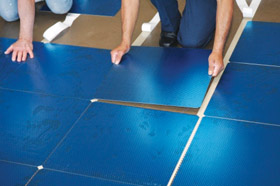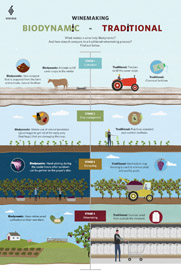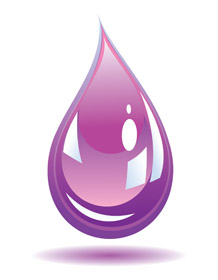Sliding to Safety

When a magnitude 6.0 earthquake shook Napa Valley last August, the result was millions of gallons (and dollars) in lost wine. Luckily, no one was seriously injured when all those full barrels—estimated at 600 pounds each—came crashing down from racks where they’d been stacked. That close call sparked interest in Napa-based EQX Global, a research and engineering firm that’s developed a protective flooring system that could minimize such catastrophes in the future.
The patented, integrated tile system uses stainless steel plates sandwiched together, one covered in a special polymer coating and the other with a slightly bumpy texture. When the ground moves violently (as in an earthquake), the plates jostle back and forth over each other, dissipating most of the energy. Company founders Paul Segas and Don Clyde have already found success with data centers, pharmaceutical companies and museums, all of which have large, valuable objects, technology, equipment or supplies that are vulnerable to earthquake or blast wave damage.
For a video simulation of the flooring in a winery setting, visit eqxglobal.net/video/wine, or go to eqxglobal.net for more information.
Mazel Tov
 The clever folks at Vivino keep entertaining with wine lists for every occasion. Whether it’s a season, holiday or a more specific category (wines by country, mood, price or varietal, for example), the Vivino team is ready with wine suggestions for you. Recent lists include wine guides inspired by Chinese Zodiac signs, St. Patrick’s Day and “Five Wines from the World’s Smallest Wine Countries.” Visit the website or download the app to view a roundup of green wines (Happy Earth Day!) or Israeli kosher wines for Passover.
The clever folks at Vivino keep entertaining with wine lists for every occasion. Whether it’s a season, holiday or a more specific category (wines by country, mood, price or varietal, for example), the Vivino team is ready with wine suggestions for you. Recent lists include wine guides inspired by Chinese Zodiac signs, St. Patrick’s Day and “Five Wines from the World’s Smallest Wine Countries.” Visit the website or download the app to view a roundup of green wines (Happy Earth Day!) or Israeli kosher wines for Passover.The Right Sort
One of the hot topics at Wine Business Monthly’s recent Innovation + Quality conference (IQ) in Napa Valley was optical sorting, which promises to sort grapes quickly, accurately and with less manpower.
Traditionally, winegrapes are sorted by hand to remove over- and under-ripe fruit, stems and other unwanted matter before they’re pressed and winemaking begins. It’s a deliberate process subject to human error—and when the goal is fine wine, mistakes can be costly.
An “optical eye sorter” can be precisely calibrated to seek out perfect berries (according to winemaker specs) and discard everything else. And, according to manufacturer estimates, the machines can process as much as 2,000 berries per second (10 to 12 tons per hour), significantly more than by-hand or using equipment like a vibrating sorting table.
At IQ, Dan Kosta (Kosta Browne Winery) moderated a panel of winemakers, all of whom had used the technology for at least one harvest, and opinions were mixed. All agreed that it worked well, but some questioned how necessary it was given the expense (close to six figures). Overall, optical sorting is getting a thumbs-up from the international wine industry. Several North Bay wineries, including Hall, Benziger Family Estate and Conn Creek Winery, have already made the investment (either purchasing or renting the equipment for recent harvests).
Did You Know?
There are more chemical compounds in wine than in bood.
Source: m.bottlenotes.com




